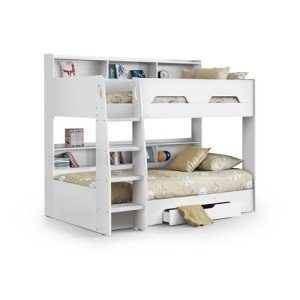20 Trailblazers Setting The Standard In Bunk Beds Children's
The Ultimate Guide to Bunk Beds for Children: Safety, Styles, and Benefits
When it concerns styling a child's space, parents frequently face the double challenge of taking full advantage of space while guaranteeing convenience and performance. Bunk beds have actually become a popular option that deals with these needs, providing not just sleeping arrangements but also adding to a space's visual. In this detailed guide, we will dive into various elements of kids's bunk beds, concentrating on their benefits, safety features, designs, and considerations for moms and dads considering this purchase.
Table of Contents
- Benefits of Bunk Beds
- Safety Features to Consider
- Types of Bunk Beds
- Design and Style Options
- Maintenance Tips
- Frequently Asked Questions (FAQs)
1. Advantages of Bunk Beds
Bunk beds offer many advantages for kids and their parents. Here are some essential advantages:
Space-Efficiency: Bunk beds are an exceptional service for smaller sized spaces. By stacking one bed on top of another, more floor space is offered for play, storage, or research study areas.
Affordable: When kids share spaces, bunk beds can lower the requirement for buying 2 different beds, thus saving money.
Fosters Social Interaction: Bunk beds can help siblings or buddies bond by sharing a space, creating opportunities for social development.
Enjoyable Factor: The concept of sleeping “up high” includes a playful aspect to bedtime, making the shift to sleeping alone easier for some kids.
Versatile Design: Bunk beds are available in different styles, colors, and creates to match any room style, enabling for customization that shows the child's character.
2. Safety Features to Consider
Security is vital when it pertains to kids's furnishings, specifically in the case of bunk beds. Here are some crucial security functions to evaluate:
Safety Feature
Description
Tough Construction
Frames made from strong wood or metal are preferred.
Guardrails
Should be at least 5 inches high and extend along both sides of the upper bunk.
Ladder Design
Make sure ladders are securely attached and have non-slip steps.
Bed mattress Size & & Fit
Must fit comfortably within the frame to avoid gaps.
Weight Limit
Always abide by the maker's weight limitation recommendations.
3. Kinds Of Bunk Beds
Bunk beds come in several designs, accommodating numerous needs, preferences, and room sizes. Here are some common types:
Standard Bunk Bed: The most basic type, with one bed on top of another.
Loft Bed: Features a high upper bed with space below for a desk or play area.
Futon Bunk Bed: Combines a top bunk with a futon on the bottom, providing flexibility for seating and sleeping.
L-Shaped Bunk Bed: This style has the leading bunk set at a perpendicular angle to the bottom, developing a small corner area.
Triple Bunk Bed: Accommodates 3 kids utilizing stacked beds, suitable for large families or slumber parties.
4. Design and Style Options
When it comes to choosing a design for children's bunk beds, the alternatives are virtually endless. Here are some popular styles:
Traditional Style: Often made from wood, these bunk beds feature elaborate details and are ideal for classic or rustic-themed spaces.
Modern Style: Characterized by tidy lines and minimalist styles, modern-day bunk beds can be made from metal or wood.
Themed Bunk Beds: Some brand names offer bunk beds shaped like castles, vehicles, or playhouses, making bedtime less of a chore.
Convertible Bunk Beds: These can be separated into 2 private beds, using flexibility as kids grow.
Colorful Options: Bunk beds in lively colors can include a sense of happiness and playfulness to any room.
5. Upkeep Tips
Preserving a bunk bed is essential for longevity and security. Here are some suggestions:
Regular Inspections: Check for loose screws or bolts every couple of months and tighten them as required.
Cleaning up: Wipe down frames regularly to prevent dust build-up; consider using a vacuum for hard-to-reach locations.
Bed mattress Care: Rotate bed mattress regularly and use protective covers to prolong their life.
Look for Wear and Tear: Look for any signs of damage in the wood or metal and consider changing parts if required.
Teach Kids Safety Rules: Encourage kids to use ladders effectively and guarantee they understand the safety functions of their bed.
6. Regularly Asked Questions (FAQs)
Q1: What age is suitable for oversleeping a top bunk?
A1: Typically, kids aged 6 and older are advised for upper bunk sleeping, as they have the required motor abilities to climb safely.
Q2: Do bunk beds feature a bed mattress?
A2: Most bunk beds are sold as frames just, so you will require to purchase bed mattress independently. Make sure that the bed mattress fits the frame comfortably.
Q3: Can bunk beds be separated later?
A3: Many designs enable conversion into 2 specific beds, supplying versatility for future needs.
Q4: How can I guarantee my kid's security on a bunk bed?
A4: Comply with safety requirements and ensure guardrails, a strong frame, and a secured ladder remain in place.
Q5: Are there weight limits on bunk beds?
A5: Yes, always examine the producer's specs relating to weight limits to make sure security.
Bunk beds for kids can serve numerous purposes while ensuring safety and design. With Reilly Graysen and designs offered on the market, parents can discover an unit that not only optimizes bed room space however likewise shows their child's special tastes. As with any furnishings, understanding safety features, maintenance, and how they suit a kid's lifestyle will guarantee that these beds stay a useful furnishings service for several years to come.
Through careful consideration and adherence to security guidelines, bunk beds can supply a long-lasting, fun, and functional sleeping solution that children love.
